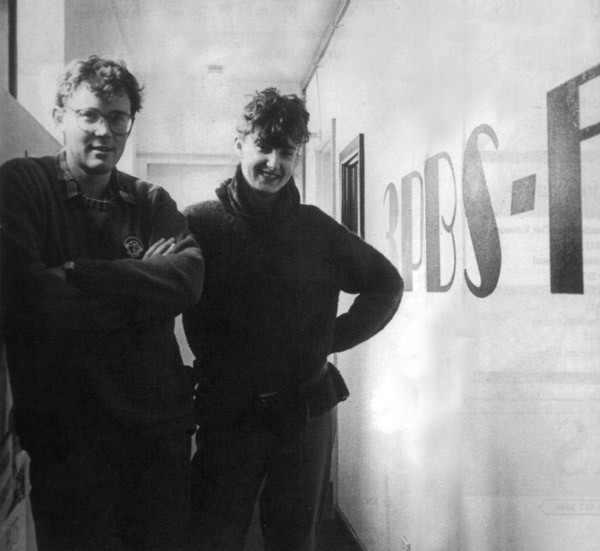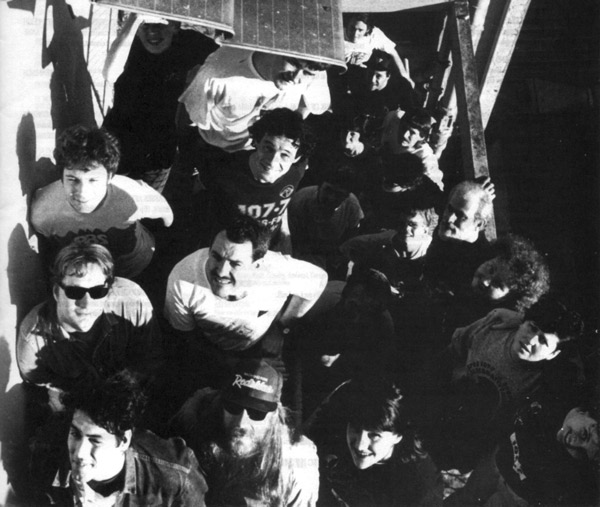Article by Anne-Marie Middlemast from the PBS Magazine Easey, 2004
What happens when a bunch of forward-thinking music lovers get together? They form a democratic co-op and create a radio station, where $20 can buy you a membership to this unique organisation. Anne-Marie Middlemast chronicles the vision and evolution of our Progressive Broadcasting Service.
In 1976 a man who would later be described as, "The Visionary" Felix Hoffman, had the grand idea to develop a public, subscription-based radio station in Melbourne. Felix pulled in a favour from a mate who was editor of the Southern Cross newspaper (then the major paper in the south-eastern suburbs), and ran a notice looking for people interested in community radio to attend public meetings.
Around the same time, Peter Jetson came up with an equally brilliant idea and stood in Bourke Street Mall handing out pamphlets encouraging potential broadcasters, technicians and music fans to do the same thing.
Needless to say Peter Jetson and Felix Hoffman combined forces, and along with a few dozen interested folk, the first PBS public meeting was held.
The house of John Maizels, on Ross Street, Port Melbourne, became PBS public meeting headquarters. Initial attendees were a mixture of punks, technicians, doctors and dentists, all realising the need in the radio sector for a station that played specialist, quality and unrepresented music. A cooperative was soon formed and it was there that the lengthy submissions to the Australian Broadcasting Tribunal (ABT), and beer-fuelled meetings began.
Ken Fargher had been involved in the FM revolution during his time in the armed forces, and upon arriving back in Melbourne, he soon found himself drawn to the PBS public meetings.
"They'd have production meetings about what they thought they would be doing if, and when we got the radio station going", he recalls. "All the tech-heads would get together and argue for what seemed like forever about nonsense. This was in 1977 way before we even began broadcasting".
The original mission statement of PBS, as pitched to the ABT, was to be a public subscription FM radio station, which supported under-represented music styles, comedy and drama. At the time, the competition for a full-time license was fierce. Other contenders included the Christian Broadcasting Group, the RMIT student radio crew and 3SR, the predecessor of 3RRR.
In between preparing lengthy submission applications the PBS co-op managed to obtain a series of test broadcast licenses, to see how well their talked-up vision would translate into informative and progressive radio.
The first PBS test broadcast took place in a bungalow out the back of John Maizels's house in Port Melbourne. Ken Fargher was one of the first broadcasters during this transmission.
"The techs had already built a panel and they had it all rigged up in this bungalow out the back of John's house," Ken recalls. "The first fellow to be on was a guy called James and I was the next shift and all of a sudden we had dead air. The whole broadcast went off air and there's technicians running around trying to figure out what's going on.
"What had happened was that they had a wire going from the bungalow through the house and to some other device, and every time you opened the screen door out the back it crimped the wire and caused the station to go off-air".
After eighteen months of sporadic test broadcasts, PBS went before the ABT and was granted with an "S" (for "Special") Class full-time radio license.
Thanks to a PBS co-op member who was also a doctor, a transmitter for the new station found it's home on the roof of the Royal Women's Hospital in Carlton. The next major agenda item was finding PBS a suitable office and broadcast space.
"We went to the newspaper to place an ad looking for premises, and we ended up getting a call from Brian Ballantyne who then owned the Prince of Wales Hotel. He offered us the rooms out the back of the hotel for nothing," Ken explains.
PBS then set about building two studios, a lounge area and a small office at the back of the Prince. The first broadcast from the new premises was on the December 21, 1979.
At this point PBS was transmitting at 107.7FM, and the broadcast range was limited. It soon became apparent that, in order to reach a vastly wider audience, a financial loss on a new transmitter would be have to be suffered. Mt. Dandenong was the location of choice.
"Our big dream was to get to the mountain and get serious coverage," says Ken. "We used to earn money for it by running Soul Shakedown parties at the Prince of Wales. Johnny Topper and myself would get bands like Asylum, The Hypnotics and Mental As Anything to play and I remember Brian coming down and saying, 'This is the best that the Prince has ever done'".
The money raised was rationed between general station running costs and the preparation of a new transmitter. Soon enough however, PBS realised they were outgrowing the Prince of Wales.
Ian Stanistreet became PBS's first paid worker, as station manager during the 1980s. He was instrumental in securing a new home for the station just up the road from the Prince-at the Ritz Mansions Park Lake Building-in August of 1984.
In an extract from a station report just before the move to the Ritz he wrote, "These last few weeks at the P.O.W spawn mixed feelings-a nostalgia for what has been a hospitable, if limiting, home for close to five years, together with a glee for what the new premises promise-space, light, better facilities-a new beginning."
And so it went; first the office move, and then the "Big One".
In November 1987, PBS finally secured its transmitter position on top of Mt. Dandenong, in a joint venture with 3MBS and the Ethnic Public Broadcasting Association of Victoria. The move also saw the withdrawal of the broadcasting restrictions, meaning that as of Monday morning on November 16, 1987, PBS was presenting specialist music programming twenty-four hours a day.
The new signal change, from 200 to 2,500 watts on top of the mountain also ushered in a change of frequency, from 107.7 MHz to the now familiar 106.7FM.
Bill Runting was involved in an "unofficial" capacity during the PBS test broadcasts as an engineering student watching the mayhem. Since the early 1980s he's been on-call as the station engineer and looks after everything technical, from the microphones in the studios right through to the transmitter. Every now and then though, the radio does spit crackle.
"I sometimes wonder why I've been involved for quite so long," says Bill. "It's been a bit more than half my life and especially in an area that's effectively on-call."
In addition to clocking up the hours driving to Mt. Dandenong to fix the transmitter, Bill also had the pleasure (and pain) of rebuilding the entire PBS studio set-up when the station moved from the Ritz Mansions in St. Kilda to new premises in Easey Street, Collingwood in 2001.
"I'm very proud of the station and what it does. I think it's got fantastic potential still and the facilities that have been developed over the last few years, particularly with the move to Collingwood, have been a great leap forward for PBS. As painful as the need to move from St. Kilda was, forced by the end of a long lease, I regard it as the best thing that's ever happened to us".
In 2001 the pressure yet again hit PBS. In what could be the shortest relocation time on record, the dedicated team prepared new studios, built offices and set the Easey Street site up ready for broadcast-all in a little over thirteen weeks.
Roger Jones, PBS's current Station Manager explains, "Because we'd been in the one place for so long we were totally ill-prepared for relocation. We spent a pretty intensive four or five months looking for properties in and around St. Kilda, Richmond and Prahran. Collingwood definitely had factory and warehouse space available at an affordable rent for us."
At a cost of forty thousand dollars, volunteers, board members, announcers and subscribers pulled it together for the first transmission from 47 Easey Street on the November 27, 2001. Volunteers constructed around 95 per cent of the new site, with the remaining work completed by paid tradesmen.
What is it about PBS that creates the urge to volunteer? Roger believes there are many motivations to volunteering, but without a doubt the common motivation is a passion for music. Sometimes this passion can get a little over-focussed and extreme.
"I had a call the other day from someone who rang in on a show, saying that the interview the announcer was doing was too long. I asked him 'How long is long enough?' and he said 'Four minutes on the spot'. Apparently he times them all. He suggested that the announcer should be disciplined. Music is a passionate thing and passion comes out in lots of different ways and sometimes it isn't always nice, but it's incredible. That's been a real eye-opener for me."
Roger sums it all up, "The incredible love of music is what unites our community and makes PBS FM a unique and amazing station."
Beginning her radio career at PBS, Anne-Marie Middlemast is now an ABC announcer and SBS radio producer.

